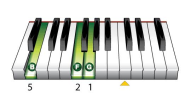To trigger a C major chord you would have to play C and the E above it, or C-E-G in any inversion. if you just play a C, the keyboard will sound a C note in two octaves, and not the third nor the fifth of the chord.
If you play C and G above, you will get C [1+5] with the third omitted, which is sometimes called a "power chord." Neither major nor minor, these occur in some heavy metal and rock songs, but are still much rarer than ordinary major chords.
If you play the G below C, Yamaha interprets this as an "on bass" or "slash" chord. It will play a C major chord with G in the bass. This would be written 'C/G.' This type of slash chord recognition is useful. But most other brands have it as a separate control, which is actually more flexible because you can turn it off when not needed, and then play chords in any convenient inversion.
To answer your last question: If you play two C's an octave apart, Yamaha treats this the same as just playing a single C-note. You'll hear only C in two octaves, no 3rd, no 5th. So on the PSR-SX900 there's no reason to span the octave because you can get the same sound by playing a single 'C'.
I just don't understand why Yamaha didn't set it up so that one note plays a full major chord. All of the other brands do it this way, and it makes it much easier to play simple folk songs, or any song that has a fast progression containing major chords. With single-note fingering you don't have to worry about playing a specific inversion, and often you can reach that note without having to reposition your whole hand.

